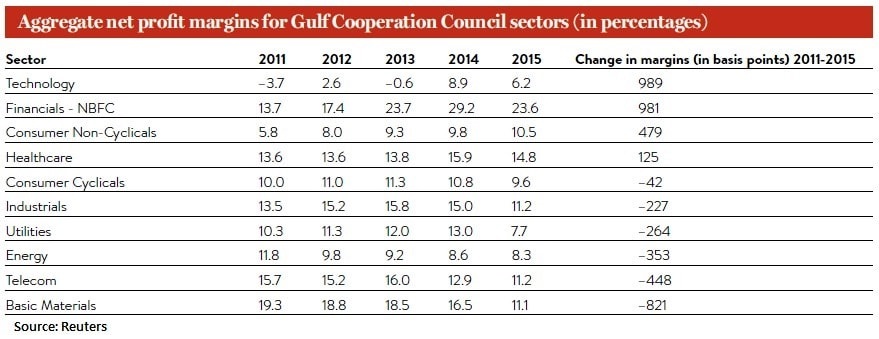Profit margins in sectors such as basic materials, industrials, energy, utilities and telecommunication services have been affected by various factors.
Subdued activity in the infrastructure space, softening real estate activity and a prolonged working capital cycle have eroded margins for contractors and construction material providers.
For firms operating in the energy and industrial sectors, lower realisations for petrochemical products and a stronger currency has affected margins. Intense competition, leading to a declining average revenue per user, a saturated market and foreign exchange losses have restrained profit margins for telecommunication service providers.
On the other hand, firms in technology, finance – particularly the non-banking financial corporations – healthcare and consumer non-cyclical sectors have all done well over the past five years.
Margins for firms providing financial services such as loans, working capital, insurance, wealth management products and leasing solutions have expanded the most. The lower cost of capital, ample liquidity and regulations that call for the mandatory purchase of insurance have aided in their stellar growth.
Post the global financial crisis, regional banks went into deleveraging mode as they sought to clean up their books. Their conservative stance following this has focussed on large-scale corporations while the lucrative small and medium sized enterprise space was largely ignored.
Small and medium sized enterprise loans, as a percentage of bank credit, is among the lowest in the region, indicating the lack of attention the sector has been given. Non-banking financial corporations, with their localised presence, have leveraged this opportunity and effectively serviced it, increasing their margins in the process.
Food processing firms, retailers, fast moving consumer goods players, wholesale distributors and traders have also done well. Favourable demographics, rising per capita incomes and a lifestyle which is consumption-driven have benefitted the consumer non-cyclical sector.
The prevalence of lifestyle diseases such as obesity and a spurt in medical tourism has resulted in healthy margins for hospitals, medical equipment manufacturers and pharmaceutical distributors.

Going forward, we expect margin pressures to continue in basic materials, industrials and energy sectors. Oil is not expected to rebound any time soon and restrained government spending could lead to stalled infrastructure projects. Poor labour productivity will continue to squeeze margins in labour intensive sectors while increasing interest rates and liquidity problems could be a headwind for financials.
It is hard to sustain higher margins as profitable industries are bound to attract competition. However, companies that can successfully create moats by establishing a significant competitive advantage over their rivals can sustainably grow their profits. This, however, is easier said than done.
Additionally, profitability is just one part of the equation. Profitability along with sustainable long-term growth adds significant value to the stakeholder. Identification of opportunities for growth should be of significant importance for management teams.
While profitable operations ensure survival of the firm, evaluating growth opportunities and successfully investing in them creates value and leads to long-term success.
Stay Tuned To Marmore MENA Insights!
Never miss a patch or an update with Marmore's Newsletter. Subscribe now!
Related Article
Kuwait’s Approval of Public Debt Law: Re-emerging on Investors’ Radar
Kuwait has passed the long-awaited debt law in March 2025. The blog explores the importance of the law, the expected benefits and outlook for the countrys return to debt markets.
Read MoreThe Dynamic Rise of Fintech in the GCC
The convergence of technology and finance is reshaping the GCC Financial Ecosystem. The blog explores key players, regulatory framework and market dynamics of Fintech in the GCC region.
Read MoreHow secure are GCC banks compared to their global counterparts?
The blog examines the impact of cyber attacks on financial institutions and the resiliency of GCC banks compared to their global counterparts
Read More




